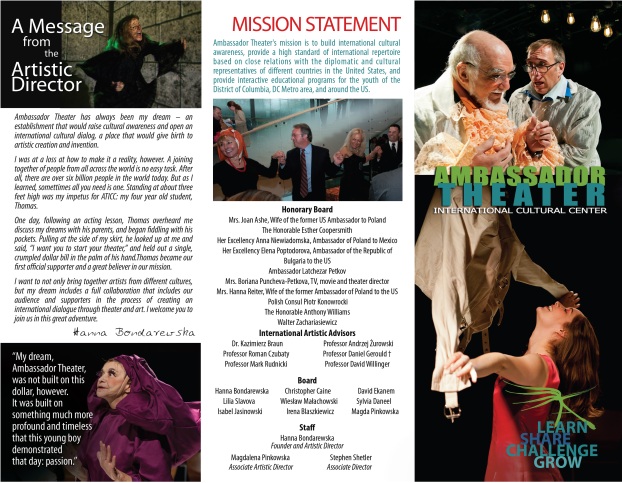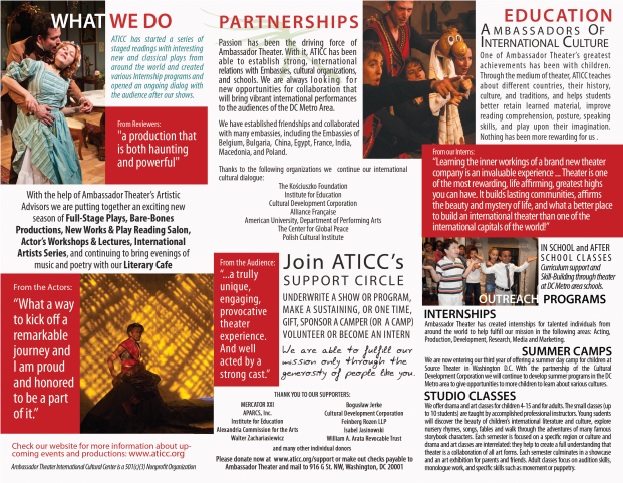As The Third Breast opens, the cast sings, accompanied by acoustic guitars, tambourines, and a flute, as if around a mid-summer bonfire, and they invite the audience into the fold of their valley “commune†through the offer of libations. It seems as if one is walking into a 1969 love-fest, yet the audience leaves feeling as alienated from the world as readers emerging from a George Orwell novel, which is the point.
Eva (Sissel Bakken) illuminates the commune—she is the personification of the peace around which it sustains itself. Thomas (Christopher Henley), her former lover, choreographs its on-goings as the architect willing to do anything to preserve it, including keeping Eva sainted in the eyes of the members. Together they pull newcomer George (Matthew Ingraham), an attractive, young drifter, into a twisted love as they all try to reconcile what the third breast, which quite literally manifests on Eva’s side below her left breast, symbolizes to them, their relationships, and the commune.

(l-r) Sissel Bakken, Matthew Ingraham and Christopher Henley)
The breast begins as a discoloration and grows into an unsightly anomaly that makes Eva feel monstrous. Thomas too fears what people will think and, more importantly, wants to keep her as the commune’s center piece. Eva seeks comfort from several men as she contemplates suicide until Thomas goes to George, who has the right mix of kindness and ruthlessness that may help Eva out of her despair. The breast fascinates George and becomes a thing of worship as if Eva were a Goddess out of India mythology. As they make love for the first time, he unwraps a bandage around Eva’s torso to hold and kiss it tenderly. Still, both Eva and Thomas worry about how it will affect the commune as a whole. The other men Eva had sought comfort from did not embrace it as George did. Eva, fearing they will betray her secret, declares that they must be killed.
In a subtle, excellent power play, Thomas (and Eva) puppeteer George into the role of murderer. Because he loves Eva–because he worships the third breast–he agrees. It is an act from which the free spirited, kind George never returns as — emboldened by the power of the murder –takes control of the commune, turning it into a military-like camp where members are little better than prisoners.
While Bakken doesn’t show as much of the radiating, magnetic charisma of Eva, her long, flowing blonde hair and stature and her earthiness fill Eva with a relatable, palpable vulnerability that makes her trajectory—from Goddess to murderer—all that more sickening.
Ingraham as George is kind and lighthearted. There is a certain natural buoyancy and sweet naïveté about the actor that makes George’s ruthlessness a bit hard to believe, especially as he descends into the commune dictator, though Ingraham does play it well.
Henley’s Thomas is the most nuanced performance of the show. His quest for peace and his use of power set the stage for George’s reign of terror, yet, as he articulates that “all obligation comes with handcuffsâ€Â you understand that living with and balancing the dichotomies of humanity is an art form. Thomas is sly and suspect from the opening, so his support of Eva’s grand plan to murder those who know about and rejected her third breast and his coercion of George does not surprise. Yet, in the aftermath, he is the voice of a sanity and reason.
Watching a utopia, of sorts, devolve into a dystopia isn’t new – the concept has long been present in literature – but the catalyst, the third breast, is genius. It is something both serious and almost comical, giving credence to the idea that fighting, warring, arguing, terror, etc…have been started over less. While it is literal in the play and poses a potential health threat to Eva–what if it were a tumor?–it is symbolic of a greater stain on humanity. It cripples Eva with fear; it drives George to obsession; it upsets Thomas’ perfect commune. It is easily removable, yet murder seems more palatable to Eva, George, and Thomas, each of whom seem to derive power from it.
Polish playwright Ireneusz Iredynski, long known in his homeland, died in 1985 and much of his work is not easily found in America, yet The Third Breast’s themes are timeless across countries. He illustrates that righteousness and freedom turn to obsession and captivity when mixed with want of power, vanity, and sex. They play just as well against the WWII era in which he was born as they do against Vietnam and now Iraq and Afghanistan.
The real star of the show is the direction by Hanna Bondarewska. The atmosphere she creates–shading something akin to Woodstock into an Orwellian nightmare–fully envelops the audience. She presents complex ideas boldly and gives a World Premiere to a playwright who has little name recognition in the US. It is a risky move, but well worth it as Iredynski is someone I, personally, want to see more from, feeling as if I have missed an important voice in the literary canon up until now.
The Third Breast is a captivating look at humankind. A show worth seeing. But, be prepared for darkness.
The Third Breast by Ireneusz Iredynski, Translated by Sylvia Daneel, Directed by Hanna Bondarewska. Featuring Sissel Bakken, Christopher Henley, and Matthew Ingraham. Set Design: Antonio Petrov. Costume Design: Sigrid Johannesdottir. Music: Paul Oehlers, Sound: Paul Oehlers and George Gordon, Visual Effects: George Gordon . Produced by Ambassador Theatre .
Reviewed by Kelly McCorkendale
Highly Recommended
The Third Breast
Closes August 4, 2013
Mead Theatre Lab
at Flashpoint Gallery
916 G Street NW
Washington, DC
2 hours, 15 minutes with 1 intermission
Tickets: $35
Thursdays thru Sundays
Details
Tickets
 Two friends sit in a study, sipping brandy. Both are intellectuals; one is a dissident, while the other has become a collaborator. Summarizing the state of television, one of the men laments, “Nothing but sterility and intrigues.†It’s a fitting description for this production of Protest, as Ambassador Theater presents an intellectually intriguing – if not emotionally satisfying – take on a modern classic. Protest is the final event of the 2013 Mutual Inspirations Festival, celebrating the life and work of artist-dissident Václav Havel, and the final play in “Havel’s Trilogy.†Featuring Havel’s most lasting contribution to the theater, the partly autobiographical character of Ferdinand VanÄ›k became a national symbol. InProtest, Vanek (Michael Crowley) goes to visit his old friend Stanek (Ivan Zizek) – don’t worry, the similiarity in name is intentional. Where Vanek was recently jailed by the authorities for his political views, former comrade Stanek has reached an accord with the government and found himself a comfortable position writing for television. The two men mirror each other, each viewing the other as an object lesson in might-have-beens. Stanek wants Vanek’s help with a tricky political situation, hoping that his politically active friend will be willing to take all the risks….To Read More
Two friends sit in a study, sipping brandy. Both are intellectuals; one is a dissident, while the other has become a collaborator. Summarizing the state of television, one of the men laments, “Nothing but sterility and intrigues.†It’s a fitting description for this production of Protest, as Ambassador Theater presents an intellectually intriguing – if not emotionally satisfying – take on a modern classic. Protest is the final event of the 2013 Mutual Inspirations Festival, celebrating the life and work of artist-dissident Václav Havel, and the final play in “Havel’s Trilogy.†Featuring Havel’s most lasting contribution to the theater, the partly autobiographical character of Ferdinand VanÄ›k became a national symbol. InProtest, Vanek (Michael Crowley) goes to visit his old friend Stanek (Ivan Zizek) – don’t worry, the similiarity in name is intentional. Where Vanek was recently jailed by the authorities for his political views, former comrade Stanek has reached an accord with the government and found himself a comfortable position writing for television. The two men mirror each other, each viewing the other as an object lesson in might-have-beens. Stanek wants Vanek’s help with a tricky political situation, hoping that his politically active friend will be willing to take all the risks….To Read More

















